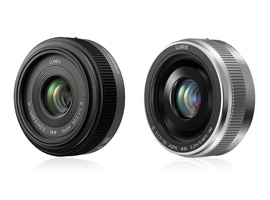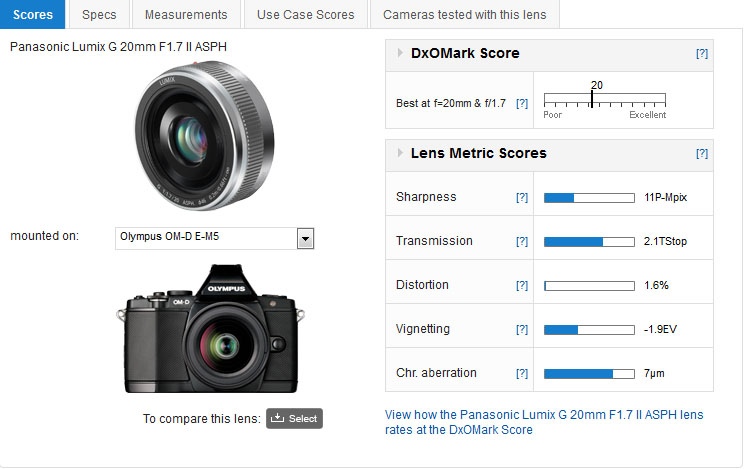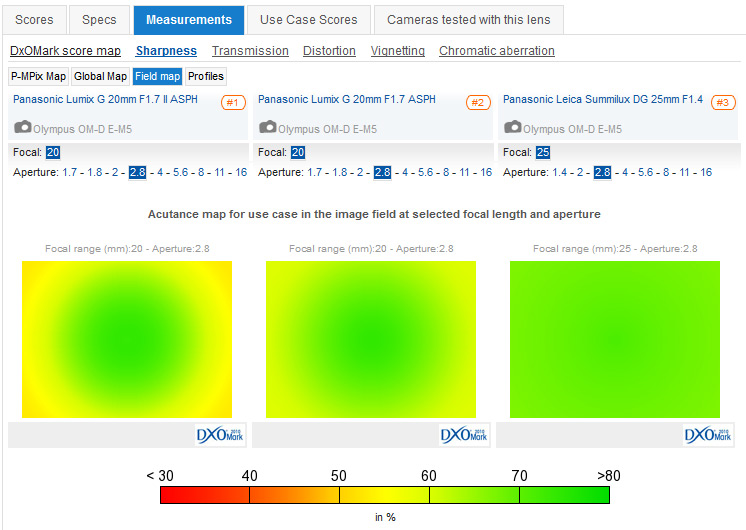Introduction
Besides the small size and inherent portability of the MFT format cameras, both Panasonic and Olympus were quick to capitalize on the attraction of equally small high-quality primes. Panasonic even trumped Olympus (one of the most respected lens makers in Japan) early on and introduced a small pancake-type ‘normal’ lens with fast focusing, a large maximum aperture and very high image quality. That lens was the Lumix G 20mm f1.7 ASPH, and although only announced late 2009, Panasonic has already introduced its successor, the $428 Lumix G 20mm f1.7 II ASPH.
While the new lens has a revamped metallic (silver or black) finish, the firm says the optical formula remains unchanged. As with the original the new mode features seven elements in five groups with two elements using an aspherical surface for reduced chromatic aberration and distortion. Both models focus to a close 20cm, measure just 25.5mm in length and feature a 46mm filter thread. However the new model is slightly lighter at just 87g (3.07 oz), compared with the 100g (3.53 oz) of the now discontinued original.
Although the original was highly regarded, the range of rival offerings has increased dramatically. Olympus introduced a high-grade 17mm f1.8 model to compete directly, and Panasonic added a Leica branded 25mm f1.4 that must surely be tempting sales away from the diminutive 20mm.
Add the $999 Voigtlander 17.5mm f0.95 and more modest $199 Sigma 19mm f2.8 DN Art series lens to the mix (both untested at the time of posting), and it’s understandable Panasonic felt the need to refresh the 20mm.
 |
 |
 |
 |
| Olympus M.ZUIKO DIGITAL ED 75mm F1.8 | 899 | 27 | 13 |
| Panasonic Leica Summilux DG 25mm F1.4 | 579 | 23 | 11 |
| Olympus M. Zuiko Digital ED 45mm f1.8 | 389 | 23 | 9 |
| Olympus M.ZUIKO DIGITAL 17mm f1.8 | 500 | 22 | 7 |
| Olympus M. Zuiko Digital ED 12mm f2.0 | 769 | 21 | 11 |
| Sigma 60mm F2.8 DN A Micro 4/3 | 239 | 21 | 11 |
| Panasonic Lumix G 20mm F1.7 ASPH | 400 | 21 | 12 |
| Panasonic Lumix G 20mm F1.7 II ASPH | 400 | 20 | 11 |
| Olympus M.ZUIKO DIGITAL ED 60mm F2.8 Macro | 499 | 19 | 11 |
| Sigma 30mm F2.8 DN A Mount 43 | 199 | 18 | 9 |
| Panasonic Leica DG Macro-Elmarit 45mm F2.8 ASPH OIS | 668 | 17 | 9 |
| Olympus M.ZUIKO DIGITAL 17mm f2.8 | 300 | 15 | 7 |
| Olympus 15mm 1:8.0 Body Cap | 79 | 5 | 3 |
When compared with against rivals with similar focal lengths, the new lens ranks third, surprisingly, behind the original model and the Olympus M. Zuiko 17mm f1.8 although it outperforms the latter lens in overall image sharpness.
 |
 |
 |
 |
| Panasonic Leica Summilux DG 25mm F1.4 | 579 | 23 | 11 |
| Olympus M.ZUIKO DIGITAL 17mm f1.8 | 500 | 22 | 7 |
| Panasonic Lumix G 20mm F1.7 ASPH | 400 | 21 | 12 |
| Panasonic Lumix G 20mm F1.7 II ASPH | 400 | 20 | 11 |
| Sigma 30mm F2.8 DN A Mount 43 | 199 | 18 | 9 |
| Olympus M.ZUIKO DIGITAL 17mm f2.8 | 300 | 15 | 7 |
With an overall DxOMark lens score of 20 points on the E-M5, the revamped lens achieves a very good score overall. Sharpness is high for a bright lens such as this and chromatic aberration is low. On the flipside, sharpness across the field isn’t particularly consistent and both distortion and vignetting are high. Panasonic cameras remove vignetting, CA and correct distortion on both out of-camera JPEGs and in RAW files with certain software, however the price for this convenience is a slight loss of sharpness in the final image. Olympus MFT cameras perform slightly differently to their rivals from Panasonic. They automatically remove distortion and vignetting but correction for lateral chromatic aberration is a new feature to the top-of-the-range OM-D E-M1.
Panasonic Lumix G 20mm F1.7 II ASPH vs Panasonic Lumix G 20mm F1.7 ASPH vs Panasonic Leica Summilux DG 25mm F1.4
Slight differences in performance arise between the two 20mm models
Compared to its predecessor the new lens should perform similarly, but we measured some slight variation in optical quality. The new model has a slight loss of sharpness in the corners and edges over the previous iteration. Sharpness in the outer field doesn’t quite match the original even when stopped down.
Against the brighter Leica 25mm, the new model has similar levels of sharpness overall but lacks the consistent, edge-to-edge sharpness of that lens when stopped down.
Chromatic aberration is lower but that’s expected to a degree.
The original Panasonic Lumix G 20mm f1.7 ASPH was one of the most prized lenses for both Panasonic and Olympus users and the announcement of a revamped model with the same optical construction was a surprise.
In reality, the Panasonic Lumix G 20mm f1.7 II ASPH performs very slightly differently to the original. It’s still an excellent lens, but it’s not quite the performer of it illustrious forebear.








DXOMARK encourages its readers to share comments on the articles. To read or post comments, Disqus cookies are required. Change your Cookies Preferences and read more about our Comment Policy.